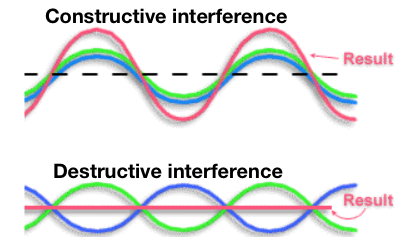Chapters
In the fascinating realm of physics, waves play a fundamental role in shaping our understanding of the universe. Waves can interact with each other, giving rise to intriguing phenomena known as interference. In this article, we will embark on a journey to delve deeper into the captivating concepts of constructive and destructive interference and the mesmerizing interference patterns they create. Furthermore, we will unravel the principles behind interference fringes, standing waves, and the factors that influence interference's intensity and phase relationships.

What is Wave Interference?
Wave interference is defined as:
"When two or more waves meet while traveling through the same medium, it's called wave interference"
If the waves arrive simultaneously and reinforce each other, they become stronger. But if they arrive at different times and interfere, they can cancel each other out. You can imagine this by picturing two waves travelling in opposite directions along a rope.
In Phase and Out of Phase
When two waves that look the same come together, and their highest point (crest) matches up perfectly with the highest point of the other wave, and the lowest point (trough) matches up perfectly with the lowest end of the other wave, we say they are "in step" or "in phase".
On the other hand, when two waves that look the same come together, but this time the highest point of one wave overlaps with the lowest point of the other wave, and the lowest point of one wave overlaps with the highest point of the other wave, we say they are "out of step" or "out of phase".
Constructive Interference
When two waves meet in a manner where their crests align perfectly, they combine to form a larger wave. This phenomenon is known as constructive interference. The waves reinforce each other, resulting in an increased amplitude and intensity. It occurs when the waves are "in phase" or perfectly synchronized. Imagine two friends pushing a swing at the same time and rhythm – their combined effort will make the swing go higher and higher.
Destructive Interference
In contrast to constructive interference, destructive interference occurs when two waves meet, and their crests align with the troughs of the other wave. As a result, the waves cancel each other out, decreasing amplitude and intensity. Destructive interference occurs when the waves are "out of phase" or not synchronized. Visualize two friends pushing a swing at different times but with equal force – their efforts will counteract each other, causing the swing to remain stationary.

Interference Patterns
When waves interact and overlap, they give rise to captivating interference patterns. One unique example is the formation of interference fringes, alternating areas of light and darkness that emerge when light waves interfere. These fringes can be seen in different scenarios, such as when light passes through narrow openings or reflects off thin layers.
Studying these patterns has provided valuable knowledge about the nature of light and wave properties, leading to groundbreaking advancements in optics and spectroscopy. By analyzing interference patterns, scientists have unlocked a deeper understanding of wave behaviour and harnessed this knowledge to transform our experience of light and its applications.
Standing Waves
Standing waves are a remarkable manifestation of interference. They occur when two waves with the same frequency and amplitude travel in opposite directions and interact constructively. Standing waves appear to be stationary, unlike most moving forward or backwards, creating distinctive patterns.
Example
Imagine a rope tied at one end and held tight by a person at the other. When the person moves their hand up and down, waves travel along the rope. These waves bounce back when they reach the tied end.
When the incoming and reflected waves meet, they mix. If the waves have the right frequency, something remarkable happens: standing waves appear on the rope. Some parts of the cord stay still like they're not moving; we call those parts "nodes." Other parts of the rope move the most, reaching the highest and lowest points, and we call those parts "antinodes."
Different standing wave patterns show up by changing how fast the person moves their hand. For example, if the hand movement matches the natural frequency of the rope, we see a simple pattern with one node and one antinode. This is the primary mode or the first harmonic.
As the hand moves faster, more nodes and antinodes pop up, creating higher harmonics. The second harmonic has two nodes and one antinode. The third harmonic has three nodes and two antinodes, and so on.
This idea of standing waves on a rope resembles that of musical instruments like guitars and pianos. By changing the instrument's length, tightness, and other factors, we can produce different standing wave patterns, which create different musical tones and pitches.
Understanding standing waves is important in physics because it helps explain resonance and how waves behave in different systems.
Factors Influencing Intensity and Phase Relationships
Several factors play crucial roles in determining the intensity and phase relationships in interference:
- Amplitude: The amplitude of the waves involved directly affects the resulting intensity. A larger amplitude leads to a higher power of the resultant wave.
- Path Difference: The path difference between the interfering waves determines whether they will interfere constructively or destructively. Constructive interference occurs if the path difference is an integer multiple of the wavelength. Conversely, destructive interference occurs if the path difference is a half-integer wavelength multiple.
- Medium Properties: The properties of the medium through which the waves propagate can influence interference. For example, the refractive index of a medium affects the phase relationship between waves, altering the interference pattern.
- Frequency and Wavelength: The frequency and wavelength of the waves determine their phase relationship and how they interfere with each other. Waves with the same frequency and wavelength interfere constructively or destructively, depending on their relative phase.












You are the best,, coz you have gotten content about the topics
Hello ! Glad to hear that you’ve found the content useful!